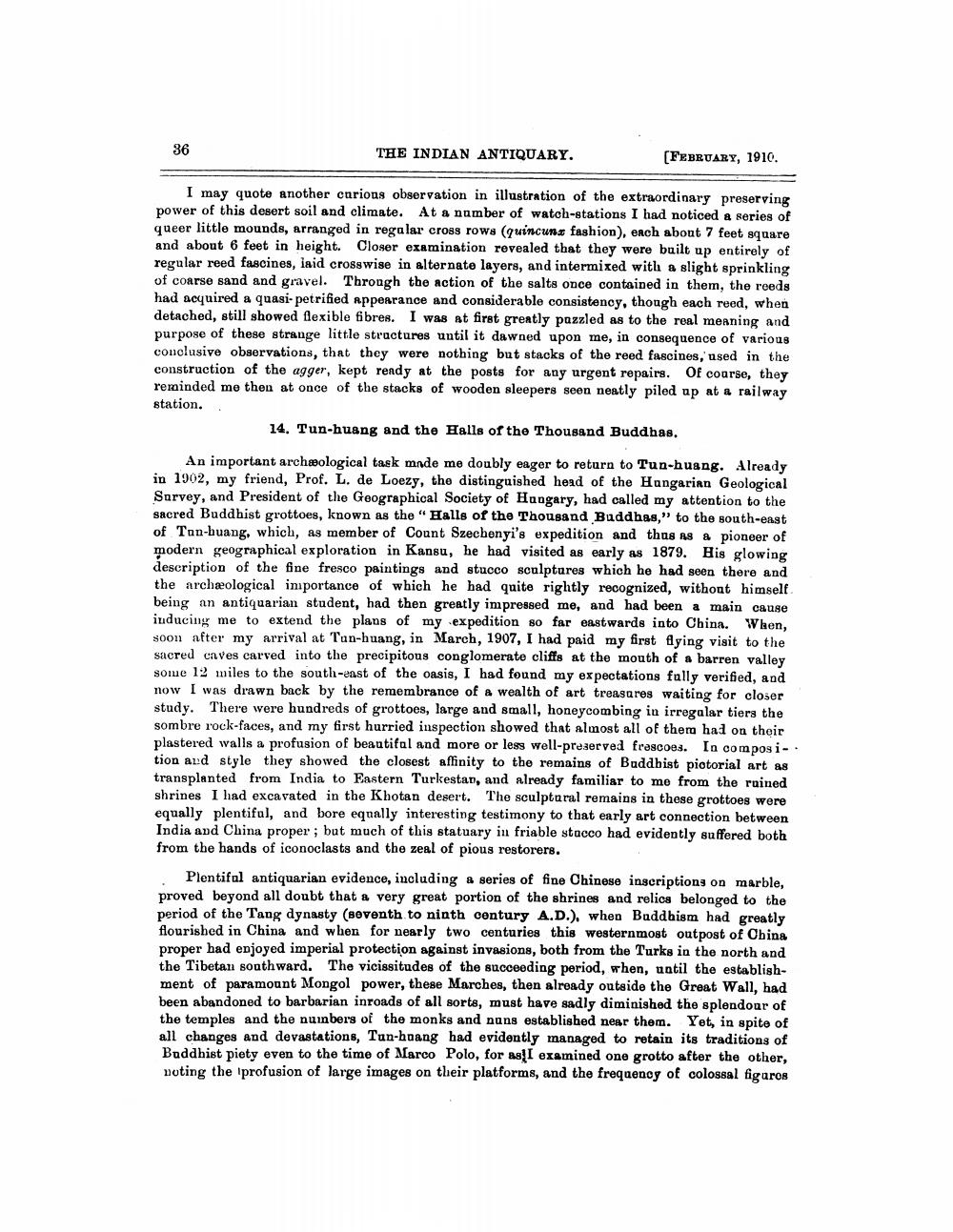________________
THE INDIAN ANTIQUARY.
(FEBRUARY, 1910.
I may quote another curions observation in illustration of the extraordinary preserving power of this desert soil and climate. At a namber of watch-stations I had noticed a series of queer little mounds, arranged in regalar cross rows (quincuns fashion), ench about 7 feet square and about 6 feet in height. Closer examination revealed that they were built up entirely of regular reed fascines, iaid crosswise in alternate layers, and intermixed with a slight sprinkling of coarse sand and gravel. Through the action of the salts once contained in them, the reeds had acquired a quasi-petrified appearance and considerable consistency, though each reed, when detached, still showed flexible fibres. I was at first greatly pazzled as to the real meaning and purpose of these strange little structures until it dawned upon me, in consequence of various conclusive observations, that they were nothing but stacks of the reed fascines,' used in the construction of the agger, kept ready at the posts for any urgent repairs. Of course, they reminded me then at once of the stacks of wooden sleepers seen neatly piled up at a railway station.
14. Tun-huang and the Halls of the Thousand Buddhas,
An important archeological task made me doubly eager to return to Tun-huang. Already in 1902, my friend, Prof. L. de Loezy, the distinguished head of the Hungarian Geological Survey, and President of the Geographical Society of Hungary, had called my attention to the sacred Buddhist grottoes, known as the "Halls of the Thousand Buddhas," to the south-east of Tan-buang, which, as member of Count Szechenyi's expedition and thus as a pioneer of modern geographical exploration in Kansu, he had visited as early as 1879. His glowing description of the fine fresco paintings and stucco sculptures which he had seen there and the archæological importance of which he had quite rightly recognized, withont himself being an antiquarian student, had then greatly impressed me, and had been a main cause inducing me to extend the plans of my expedition so far eastwards into China. When, soon after my arrival at Tan-huang, in March, 1907, I had paid my first flying visit to the sacred caves carved into the precipitous conglomerate cliffs at the mouth of a barren valley some 12 miles to the south-east of the oasis, I had found my expectations fully verified, and now I was drawn back by the remembrance of a wealth of art treasures waiting for closer study. There were hundreds of grottoes, large and small, honeycombing in irregalar tiers the sombre rock-faces, and my first hurried inspection showed that almost all of them had on their plastered walls a profusion of beautiful and more or less well-preserved frescoes. In composition and style they showed the closest affinity to the remains of Buddhist pictorial art as transplanted from India to Eastern Turkestan, and already familiar to me from the ruined shrines I had excavated in the Khotan desert. The sculptural remains in these grottoes were equally plentiful, and bore equally interesting testimony to that early art connection between India and China proper ; but much of this statuary in friable stacco had evidently suffered both from the hands of iconoclasts and the zeal of pious restorers.
Plentiful antiquarian evidence, including a series of fine Chinese inscriptions on marble, proved beyond all doubt that a very great portion of the shrines and relics belonged to the period of the Tang dynasty (seventh to ninth century A.D.). when Buddhism had greatly flourished in China and when for nearly two centuries this westernmost outpost of Obina proper had enjoyed imperial protection against invasions, both from the Turks in the north and the Tibetan southward. The vicissitudes of the succeeding period, when, until the establishment of paramount Mongol power, these Marches, then already outside the Great Wall, had been abandoned to barbarian inroads of all sorts, must have sadly diminished the splendour of the temples and the numbers of the monks and nans established near them. Yet, in spite of all changes and devastations, Tan-hoang had evidently managed to retain its traditions of Buddhist piety even to the time of Marco Polo, for as! I examined one grotto after the other, noting the profusion of large images on their platforms, and the frequency of colossal figuros




